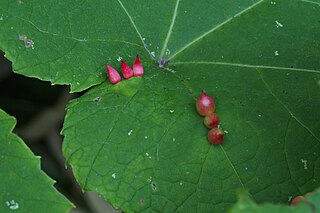
The Cecidomyiinae, commonly known as gall midges or gall gnats, is the largest subfamily in Cecidomyiidae with over 600 genera and more than 5000 described species. This subfamily is best known for its members that induce galls on plants, but there are also many species that are fungivores, parasitoids, or predators as maggots.

Asphondylia is a cosmopolitan genus of gall midges in the family Cecidomyiidae. All species in this genus induce galls on plants, especially on flowers and flower buds. There are over 300 described species in Asphondylia, with many more likely to be discovered and described, especially in the southern hemisphere.

Asphondyliini is a tribe of gall midges in the family Cecidomyiidae. There are about six genera and at least 100 described species in Asphondyliini.

Rhopalomyia is a genus of gall midges, insects in the family Cecidomyiidae. There are at least 267 described species in Rhopalomyia. Most species in this genus induce galls on plants in the Asteraceae. This genus has a cosmopolitan distribution. Rhopalomyia was first established by Ewald Heinrich Rübsaamen in 1892.
Catotricha americana is a species of basal gall midges in the family Cecidomyiidae. It is the type species of the genus and has only been confirmed to occur in New Hampshire. This species was first described by American entomologist Ephraim Porter Felt in 1908.
Catotricha is a genus of midges in the family Cecidomyiidae. The five described species in Catotricha are found in the holarctic region. This genus was established by British entomologist Frederick Wallace Edwards in 1938.

Ampelomyia vitiscoryloides, the grape filbert gall midge, is a species of gall midge in the family Cecidomyiidae. It induces galls on grape plants and is widespread in eastern North America. It was first described by Alpheus Spring Packard in 1869.
Micromyinae is a subfamily of wood midges, insects in the family Cecidomyiidae. Its members were formerly included in subfamily Lestremiinae. There are at least 55 genera and more than 650 described species in Micromyinae. All species in this subfamily are mycophageous.
Amedia is a genus of wood midges in the family Cecidomyiidae. The only described species - Amedia floridana - is only known from Florida. The genus was established by Mathias Jaschhof in 1997.

Ampelomyia vitispomum is a species of gall midge in the family Cecidomyiidae. It induces galls on grape plants in eastern North America. It was first described by Carl Robert Osten-Sacken in 1878.

Olpodiplosis is a monotypic genus of gall midges, insects in the family Cecidomyiidae. The only described species is Olpodiplosis helianthi.
Daphnephila is a genus of gall midge that appears in the Palearctic and Oriental biogeographic realms. Daphnephila species create leaf and stem galls on species of laurel plants, particularly in Machilus. Based on analysis on sequences of the mitochondrial cytochrome c oxidase subunit I, it has been suggested that in this genus, the stem-galling habit is a more ancestral state as opposed to the leaf-galling habit.
Ampelomyia is a genus of gall midges in the tribe Asphondyliini. It consists of the following four species, all of which form galls on grape plants:
Anabremia is a genus of gall midge in the family Cecidomyiidae. The six described species are found in the Palearctic and likely inquilines of Dasineura galls on plants in the legume family. This genus was first described by Jean-Jacques Kieffer in 1912.
Raymond J. Gagné is an American entomologist whose work focuses on gall midges.
Trichoceromyia is a genus of midges in the family Cecidomyiidae. There is one described species in this genus: Trichoceromyia oregonensis. It is only known from Oregon.
Wheeleriola is a genus of midges in the family Cecidomyiidae. The one described species in this genus - Wheeleriola perplexa - is known only from New Zealand.
Antennardia is a genus of midges in the family Cecidomyiidae. The four described species are found in the Holarctic realm. The genus was first described by Boris Mamaev in 1993, but was subsequently treated as a subgenus of Monardia until being reinstated at the genus level.
Gagnea is a genus of wood midges, insects in the family Cecidomyiidae. The one described species - Gagnea tsutaensis - is known only from Japan. The genus was established by Mathias Jaschhof in 2001 and named after American entomologist Raymond Gagné.

Ampelomyia conicocoricis is a species of fly in the family Cecidomyiidae. It induces galls on grape plants in Japan. This is the type species for the genus.







